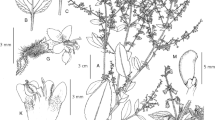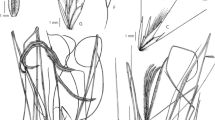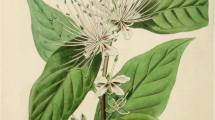Summary
Species delineation and taxonomic status of three species of Coleus Lour. from the Guinean Highlands, West Africa, are discussed in the context of related taxa. A new species, C. ferricola Phillipson, O.Hooper & A.J.Paton, is found on iron-rich substrates. The related C. splendidus A.Chev. is recognised as a distinct species with C. djalonensis A.Chev. and C. peulhorum A.Chev. var. violacea A.Chev. placed in synonymy. The new combination, Coleus lateriticola (A.Chev.) Phillipson, O.Hooper & A.J.Paton, based on Solenostemon lateriticola A.Chev., but frequently treated at subspecific rank under Plectranthus monostachyus (P.Beauv.) B.J.Pollard, is established. These taxa are described and discussed, and distribution data, illustrations and IUCN Red List assessments are also provided.






Similar content being viewed by others
References
Adam, J. G. (1981). Flore Descriptive des Monts Nimba (Côte D’Ivoire, Guinée, Libéria). Editions du Centre National de la Recherche Scientifique, Paris.
Bachman, S., Moat, J., Hill, A. V., De la Torre, J. & Scott, B. (2011). Supporting Red List threat assessments with GeoCAT, a geospatial conservation assessment tool. Zookeys 150: 117 – 126.
Beentje, H. J., Adams, B., Davis, S. D. & Hamilton, A. C. (1994). Regional Overview: Africa. In: S. D. Davis, V. H. Heywood & A. C. Hamilton (eds), Centres of plant diversity: Vol. 1, Europe, Africa, South West Asia and the Middle East WWF. IUCN, Cambridge.
Bidault, E., Lowry, P. P. & Stévart, T. (2016). Polystachya orophila (Orchidaceae, Polystachynae), a new species from tropical West Africa, and clarification on the nomenclature and taxonomy of P. microbambusa. Phytotaxa 260(3): 247 – 257.
van der Burgt, X. M., Haba, P. K., Haba, P. M. & Goman, A. S. (2012). Eriosema triformum (Leguminosae: Papilionoideae), a new unifoliolate species from Guinea, West Africa. Kew Bull. 67: 263 – 271. https://doi.org/10.1007/s12225-012-9357-5.
Champluvier, D. & Darbyshire, I. (2009). A revision of the genera Brachystephanus and Oreacanthus (Acanthaceae) in tropical Africa. Syst. Geogr. Pl. 79: 115 – 192.
Cheek, M. & Ameka, G. (2016). Macropodiella cussetiana (Podostemaceae) a new species from Côte d’Ivoire. Kew Bull. 71(21). https://doi.org/10.1007/s12225-016-9634-9.
Cheek, M. & van der Burgt, X. (2010). Gymnosiphon samoritoureanus (Burmanniaceae) a new species from Guinea, with new records of other achlorophyllous heteromycotrophs. Kew Bull. 65: 83 – 88.
Cheek, M., Challen, G., Lebbie, A., Banks, H., Barberá, P. & Riina, R. (2016). Discovering Karima (Euphorbiaceae) a New Crotonoid Genus from West Tropical Africa Long Hidden within Croton. PLOS ONE. https://doi.org/10.1371/journal.pone.0152110.
Cheek, M., Feika, A., Lebbie, A., Goyder, D., Tchiengue, B., Sene, O., Tchouto, P. & van der Burgt, X. (2017). A synoptic revision of Inversodicraea (Podostemaceae). Blumea 62: 125 – 156. https://doi.org/10.3767/blumea.2017.62.02.07.
Cheek, M. & Haba, P. (2016). Inversodicraea Engl. resurrected and I. pepehabai sp. nov. (Podostemaceae), a submontane forest species from the Republic of Guinea. Kew Bull. 71(55). https://doi.org/10.1007/s12225-016-9673-2.
Cheek, M. & Luke, Q. (2016). Calophyllum (Clusiaceae – Guttiferae) in Africa. Kew Bull. 71(20). https://doi.org/10.1007/s12225-016-9637-6.
Cheek, M., Magassouba, S., Howes, M. R., Doré, T., Doumbouya, S., Molmou, D., Grall, A., Couch, C. & Larridon, I. (2018a). Kindia (Pavetteae, Rubiaceae), a new cliff-dwelling genus with chemically profiled colleter exudate from Mt Gangan, Republic of Guinea. PeerJ 6: e4666. https://doi.org/10.7717/peerj.4666.
Cheek, M., Magassouba, S., Couch, C., Gore, C. & Blythe, A. (2018b). Three new species of Keetia (Rubiaceae-Vangueireae) from West Africa. Kew Bull. 73: 56. https://doi.org/10.1007/s12225-018-9783-0.
Cheek, M. & Williams, T. (2016). Psychotria samoritourei (Rubiaceae), a new liana species from Loma-Man in Upper Guinea, West Africa. Kew Bull. 71(19). https://doi.org/10.1007/s12225-016-9638-5.
Chevalier, A. J. B. (1909). Plantes de l’Afrique tropicale Française. Labiatae. J. Bot. (Morot) 22: 119 – 128.
Chevalier, A. J. B. (1920). Exploration Botanique de l’Afrique Occidental Française 1: Enumeration des Plantes. Paul Lechevalier, Paris.
Darbyshire, I., Pearce, L. & Banks, H. (2012). The genus Isoglossa (Acanthaceae) in West Africa. Kew Bull. 66: 425 – 439. https://doi.org/10.1007/s12225-011-9292-x.
Downes, E. & Darbyshire, I. (2017). Coleus namuliensis and Coleus caudatus (Lamiaceae): a new species and a new combination in the Afromontane flora of Mozambique and Zimbabwe. Blumea 62: 168 – 173. https://doi.org/10.3767/blumea.2017.62.03.02.
Fischer, E., Darbyshire, I. & Cheek, M. (2011). Striga magnibracteata (Orobanchaceae) a new species from Guinée and Mali. Kew Bull. 66: 441 – 445.
GeoCAT (2018). Geospatial Conservation Assessment Tool. http://geocat.kew.org.
Goyder, D. J. (2009). Xysmalobium samoritourei (Apocynaceae: Asclepiadoideae), a new species from the Guinea Highlands of West Africa. Kew Bull. 63: 473 – 475. https://doi.org/10.1007/s12225-008-9059-1.
IPNI (continuously updated). The International Plant Names Index. http://ipni.org.
IUCN (2012). IUCN Red List Categories and Criteria: Version 3.1. Second edition. IUCN, Gland and Cambridge.
Lisowski, S. (2009). Flore de Guinée. Scripta Bot. Belg., Meise.
Morton, J. K. (1962). Cytogenetic studies on the West African Labiatae. J. Linn. Soc., Bot. 58: 231 – 283.
Morton, J. K. (1963). Labiatae. In: F. N. Hepper (ed.), Flora of West Tropical Africa, Vol. 2, 2nd ed., pp. 450 – 473. Crown Agents for Overseas Governments and Administrations, London.
Mwanyambo, M. L. (2008). Phylogeny and Biogeography of Plectranthus L’Hérit. (Ocimeae: Nepetioideae: Lamiaceae) with emphasis on taxa occurring on the Nyika Plateau, Malawi. Ph.D. Thesis, University of Reading.
Paton, A. J., Bramley, G., Ryding, O., Polhill, R. M., Harvey, Y. B., Iwarsson, M., Willis, F, Phillipson, P. B., Balkwill, K., Lukhoba, C. W., Oteino, D. F. & Harley, R. M. (2009). In: H. J. Beentje, S. A. Ghazanfar & R. M. Polhill (eds), Flora of Tropical East Africa. Lamiaceae (Labiatae). Royal Botanic Gardens, Kew.
Paton, A. J., Bramley, G., Ryding, O., Polhill, R. M., Harvey, Y. B., Iwarsson, M., Willis, F, Phillipson, P. B., Oteino, D. & Harley, R. M. (2013). Lamiaceae. In: J. Timberlake (ed.), Flora Zambesiaca 8, 8. Royal Botanic Gardens, Kew.
Paton, A. J., Mwanyambo, M. & Culham, A. (2018). Phylogenetic study of Plectranthus, Coleus and allies (Lamiaceae): taxonomy, distribution and medicinal use. Bot. J. Linn. Soc. 188: 355 – 376.
Paton, A. J., Mwanyambo, M., Govaerts, R. H. A., Smitha, K., Suddee, S., Phillipson, P. B., Wilson, T. C., Forster, P. I. & Culham, A. (submitted). Coleus and Plectranthus: a tale of more than two genera. Phytokeys.
Phillips, S. M., Fofana, F. & Cheek, M. (2018). Mesanthemum tuberosum Lecomte resurrected from M. prescottianum (Bong.) Körn. (Eriocaulaceae), variation and lectotypification. Kew Bull. 73(13). https://doi.org/10.1007/S12225-018-9744-7.
Phillips, S. M. & Mesterházy, A. (2015). Revision of small ephemeral species of Eriocaulon (Eriocaulaceae) in West Africa with long involucral bracts. Kew Bull. 70(5). https://doi.org/10.1007/s12225-014-9557-2.
Pollard, B. J. (2005). Two new names in African Plectranthus L’Hér. (Labiatae). Kew Bull. 60: 146 – 148.
Pollard, B. J., Parmentier, I. & Paton, A. J. (2006). Plectranthus inselbergi B.J.Pollard & A.J.Paton, a new species from Equatorial Guinea (Rio Muni) and Gabon, with notes on other West African species of Plectranthus. Kew Bull. 61: 225 – 228.
Pollard, B. J. & Paton, A. (2001). A new rheophytic species of Plectranthus L'Hér. (Labiatae) from the Gulf of Guinea. Kew Bull. 56: 975 – 982.
Pollard, B. J. & Paton, A. (2009). The African Plectranthus expansion continues. Vale Leocus! Kew Bull. 64: 259 – 261.
Pollard, B. J. Paton, A. (2012). Further expansion of African Plectranthus L’Hér. (Lamiaceae): completing the subsumption of Isodictyophorus Briq. Kew Bull. 67: 49 – 50.
Prance, G. T. & Jongkind, C. C. H. (2015). A revision of African Lecythidaceae. Kew Bull. 70(6). https://doi.org/10.1007/s12225-014-9547-4.
Thiers, B. (continuously updated). Index Herbariorum. http://sweetgum.nybg.org/science/ih/
Acknowledgements
This research received support from the SYNTHESYS Project http://www.synthesys.info/ which is financed by European Community Research Infrastructure Action under the FP7 "Capacities" Program.
The fieldwork that led to the discovery of Coleus ferricola and the new collections of C. lateriticola was conducted during the Baseline Studies of Environmental Impact Assessments conducted for the Nimba project of the Société des Mines de Fer de Guinée (SMFG) and also for the Simandou project of Simfer S.A. We would like to thank the staff of both SMFG and Simfer S.A. for their help and assistance and the opportunity to participate in these studies. We are grateful to the curators of HNG, K, MO, P, and WAG for making their collections available for consultation.
MC thanks the Darwin Initiative of the Department of the Environment, Food and Rural Affairs (DEFRA) for support in completing this paper through the Guinea IPA project (Darwin Grant 23 – 002) and Dr Magassouba, Director-General of the National Herbarium of Guinea (Universite Gamal Abdel Nasser, Conakry) for collaboration including support with permits under the terms of the Memorandum of Collaboration with RBG, Kew. OH thanks the Emily Holmes trust for supporting his fieldwork to Guinea in 2017.
We are grateful to colleagues who participated in the field work undertaken by PBP and MC, especially Ehoarn Bidault for his excellent photographs reproduced in this article, and to staff at K, MO, P and SERG herbaria for their assistance with specimen management. We also wish to thank Andrew Brown for his excellent line drawings and the reviewers, Martin Callmander and Tariq Stévart, who both provided substantial comments and suggestions that significantly improved the original manuscript.
Author information
Authors and Affiliations
Corresponding author
Additional information
Publisher’s Note
Springer Nature remains neutral with regard to jurisdictional claims in published maps and institutional affiliations.
Rights and permissions
About this article
Cite this article
Phillipson, P., Hooper, O., Haba, P. et al. Three species of Coleus (Lamiaceae) from the Guinean Highlands: a new species, a new combination and clarification of Coleus splendidus. Kew Bull 74, 24 (2019). https://doi.org/10.1007/s12225-019-9812-7
Accepted:
Published:
DOI: https://doi.org/10.1007/s12225-019-9812-7




